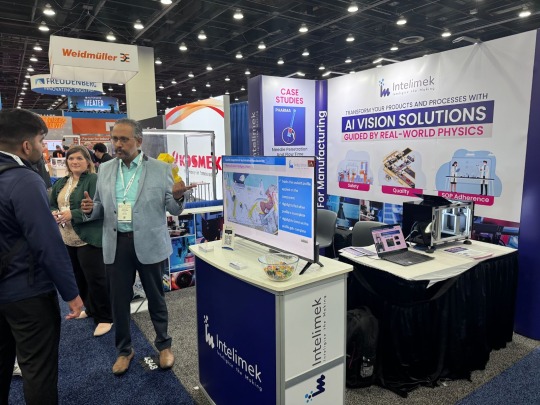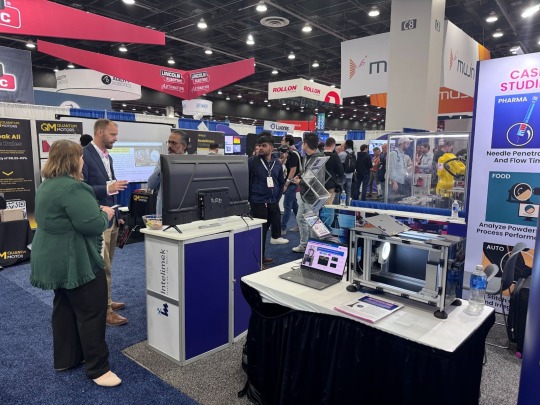#Machinevision
Explore tagged Tumblr posts
Text

International Research Awards on Computer Vision
The International Research Awards on Computer Vision aim to recognize and support outstanding contributions to the field of computer vision.
2 notes
·
View notes
Text

🔍⚙️ Inspection Equipment Market: Size, Regional Trends & Growth Forecast
✅ The global inspection equipment market was valued at USD 1.70 billion in 2024 and is projected to grow from USD 1.80 billion in 2025 to USD 2.70 billion by 2032, showing a steady CAGR of 6.0% during the forecast period.
🌏 Asia Pacific leads the way with a significant 35.29% share in 2024. Strong growth in industries like semiconductors, automotive, and electronics manufacturing continues to drive demand for advanced inspection systems in this region.
🔍 Key Trends:
⚡ Rising demand for automated and non-destructive inspection systems
🤖 Integration of AI and machine vision for precision defect detection
🏭 Expansion of smart factories and Industry 4.0 boosting adoption rates
🚀 Future Outlook: As industries strive for zero-defect manufacturing, tighter quality control, and cost efficiency, the market for inspection equipment is set to grow. Leading players are focusing on technological advancements to meet stricter regulatory standards and complex production needs.
👉 Explore the Complete Report & Insights: https://www.fortunebusinessinsights.com/inspection-equipment-market-107682
#InspectionEquipment#QualityControl#SmartManufacturing#IndustrialAutomation#MachineVision#MarketGrowth#AsiaPacific#Industry40#ManufacturingTrends#CAGR
0 notes
Text
From Doodles to Deployment: Our Journey into Physics-Guided Machine Vision
A few years ago, we started exploring AI with curiosity, dabbling in low-code/no-code tools, open-source packages, and testing out ideas to solve real problems. As our focus is primarily the manufacturing space, the excitement quickly met reality: reliable data was scarce, and accuracy couldn’t be a maybe. In production, a model either works or it doesn’t—there’s no room for ambiguity.
Coming from a mechanical engineering background, we kept asking: how do we trust a prediction if we can’t explain it? That’s what led us to evolve our thinking from pure data-driven models to Physics-Guided AI. Instead of treating model building as a standard pipeline, we began incorporating domain understanding, physics-based reasoning, and system constraints into our approach. It wasn’t just about models, it became a multi-stage workflow that blended image processing, regression, and contextual rules driven by how things actually work.
When we stepped into machine vision for inspections, we noticed a gap. Pre-trained models and vision platforms were available, but they often stopped short of delivering end-to-end solutions. Customers didn’t want components; they wanted working systems.
That’s where our approach made the difference. We applied the same physics-guided principles to machine vision solving tough inspection challenges and integrating them fully with machine control systems. At Automate 2025, this approach resonated deeply. Our live demo, featuring a smart, vision-enabled upgrade of a syringe testing system (UTM) for auto-injectors, caught attention for its practicality and execution.


This wasn’t just another proof of concept. It was a real transformation turning a traditional test system into a precise, automated inspection unit for healthcare devices.
Check out the full story in our latest blog.
Why Intelimek
At Intelimek, we transform existing equipment and processes into smart, vision-enabled systems by integrating machine vision with physics-guided AI. Instead of isolated tools, we deliver end-to-end solutions that combine domain knowledge, image intelligence, and control logic. Know more about our success stories.
1 note
·
View note
Text
instagram
#FutureOfAI#ComputerVision#VisionAI#DeepLearningTrends#AIEdgeComputing#AIInnovation#MachineVision#TechTrends2025#AITechnology#SunshineDigitalServices#Instagram
0 notes
Text
InGaAs Image Sensors Market Drivers Include Rising Demand for Infrared Industrial Vision Systems
Introduction
Rising automation, stricter quality standards, and the quest for reliable low-light inspection are propelling the InGaAs Image Sensors Market toward unprecedented growth. Made from indium-gallium-arsenide, these sensors capture visible-to-short-wave-infrared (SWIR) wavelengths, making them indispensable for modern industrial vision systems that must see beyond what silicon-based detectors can perceive. The market is expected to grow significantly as manufacturers intensify investments in photonics-enabled production lines.

1. Industrial Vision Systems Lead Demand
The strongest driver is the integration of SWIR cameras into production-floor machine-vision systems. Silicon detectors become ineffective above 1 µm, leaving inspection gaps in semiconductor wafer probing, electrolyte checks in lithium-ion batteries, and mixed-plastic sorting. In contrast, InGaAs arrays can detect moisture, organic compounds, and silicon defects through protective coatings, enabling complete, non-destructive in-line inspection. As automation expands, factories demand sensors that offer high-speed imaging and reliability under harsh operational conditions.
2. Process-Automation Economics: Why Infrared Pays for Itself
SWIR-enabled imaging reduces false rejects and rework by revealing invisible contaminants or layer thickness variations. Automotive paint shops can minimize scrap by identifying solvent pockets, while pharmaceutical production lines using InGaAs systems achieve quick return on investment due to improved defect detection. These gains help justify the higher upfront costs of InGaAs-based solutions, especially in high-volume or high-value manufacturing sectors.
3. Low-Light Advantages and Spectral Selectivity
Unlike thermal detectors that require emitted heat, InGaAs sensors operate in the reflective SWIR band (0.9–1.7 µm), providing high-contrast imaging even under low-light conditions. These sensors can work with invisible, eye-safe LED illumination, making them ideal for around-the-clock inspection. Narrow-band filtering enables detection of specific materials like epoxy, moisture, or sugars, enhancing precision without redesigning hardware, which makes InGaAs a versatile tool across industries.
4. Falling Costs and Technological Breakthroughs
Three major advances are driving costs down:
Improved manufacturing yields – Modern fabrication techniques have increased sensor yields, reducing per-unit cost.
Wafer-level packaging – Integration of micro-optics and signal processing at the wafer level lowers assembly complexity.
Flexible integration – Open firmware and modular architecture allow OEMs to customize performance without incurring licensing costs.
As a result, the total cost of deploying InGaAs-based vision systems is dropping, encouraging broader adoption even in mid-sized industrial operations.
5. Regulatory, Safety, and Sustainability Catalysts
Government regulations now push for non-contact, accurate inspection across industries like food safety, battery production, and chemical handling. InGaAs image sensors meet regulatory expectations for material detection and quality control. They also contribute to sustainability goals by enhancing combustion control in furnaces and kilns, reducing energy consumption and greenhouse gas emissions across industrial operations.
6. Regional Hotspots
Asia-Pacific: Strong manufacturing infrastructure and government subsidies are boosting domestic production and deployment of SWIR systems.
North America: Military and defense applications are accelerating InGaAs sensor demand for field-deployable systems and night-vision solutions.
Europe: Environmental compliance and industrial innovation are encouraging adoption in recycling and automation-focused sectors.
Each region is witnessing demand driven by a unique combination of policy, infrastructure, and sectoral focus.
7. Competitive Landscape
The market is currently dominated by a mix of global and regional players. Larger firms specialize in high-performance, large-format sensors for aerospace and defense, while smaller firms focus on cost-efficient solutions for industrial applications. New entrants are leveraging AI-enabled on-sensor analytics and compact form factors to address emerging use cases like portable diagnostics and mobile inspection.
8. Looking Ahead: What the Drivers Mean for Future Demand
The combination of regulatory mandates, improving economics, and performance advantages makes InGaAs image sensors increasingly attractive across industries. Demand is expanding not only in factory settings but also in outdoor, mobile, and autonomous systems. These sensors are expected to play a central role in future smart manufacturing and automated quality assurance systems.
Conclusion: Setting the Stage for Trends in Night-Vision and Surveillance
While industrial inspection remains a powerful catalyst, the capabilities of InGaAs sensors in low-light and covert environments point toward major growth in night-vision and surveillance applications. In the next article, we explore how these sectors are shaping innovation in sensor design, ruggedization, and real-time data processing.
#InGaAsImageSensors#InfraredImaging#IndustrialVision#SWIR#MachineVision#SmartManufacturing#SensorTechnology#AutomationSolutions#VisionSystems
0 notes
Text
#ASRock Industrial#AIoT#IntelCore200#EdgeComputing#SmartManufacturing#MachineVision#IndustrialPC#AIHardware#Motherboards#TechInnovation#Timestech#IndustrialAutomation#AIatTheEdge#electronicsnews#technologynews
0 notes
Text
🎧🎶 Front Line Assembly Announces "Machine Vision" by Bill Leeb! 🎧
Front Line Assembly has just announced “Machine Vision,” the new solo project from mastermind Bill Leeb! Dive into this exciting new release from the iconic electronic music pioneer. Check It Out HERE Deep Dive into the Universe of Bill Leeb and Front Line Assembly: 🎧🎶 Front Line Assembly Official Site – Bill Leeb Bandcamp – Front Line Assembly Facebook – Front Line Assembly Instagram,
#Aggrotech#billleeb#djdarkside#💀#ebm#electroindustrial#ElectronicMusic#evolradio#FrontLineAssembly#IndustrialDance#industrialmusic#MachineVision#MusicRelease#NewMusic#SoloProject
0 notes
Text
Why Flip-Off Cap Inspection Is the Missing Link in Your Pharma Packaging Line

When it comes to injectable packaging, flip-off seals are more than just aluminum caps — they’re your brand’s first line of defense in ensuring sterility, safety, and quality. Unfortunately, they’re also one of the most overlooked areas in quality control.
Enter Optomech’s FOSIS — a next-gen flip-off seal inspection system that combines machine vision, high-speed automation, and regulatory-ready software to eliminate defects before your products leave the line.
🔍 What Can Possibly Go Wrong with a Flip-Off Seal?
You’d be surprised.
During mass production, flip-off caps often suffer from:
Black spots
Short fills on the PP button
Wrinkles or dents on the aluminum shell
Color mismatches
Dust, dirt, or improper crimps
Missing caps or incomplete assemblies
Individually, these might seem minor. But together, they can:
Lead to product recalls
Fail regulatory inspections
Damage brand reputation
Cause delays in batch release
⚙️ How FOSIS Detects These Defects in Real-Time
The Flip-Off Seal Inspection System (FOSIS) uses a combination of:
High-speed vision cameras
Precision lighting and optics
Custom-developed algorithms
21 CFR Part 11 compliant software
Here's how it works:
Seals are fed through a vibratory bowl to a conveyor.
As they pass under the vision station, each cap is captured frame-by-frame.
The system checks for all defined defects in under a second.
Defective caps are immediately rejected without stopping the line.
Data is logged and reports are generated for compliance and traceability.
💼 Where Can FOSIS Be Used?
If you manufacture or package:
Injectables
Sterile vials
Flip-off caps or seals
Pharma glass bottles
…then you’re the perfect use case for FOSIS.
Whether you're a large pharmaceutical company, a contract manufacturing organization (CMO), or a packaging component supplier, FOSIS adds speed, consistency, and reliability to your inspection process.
📊 Built for Pharma Compliance & Performance
Key Features:
Inspects up to 600 caps/min
Handles cap sizes from Dia 15 mm to 36 mm
Detects over 20 defect types including:
Shell deformations
PP button cuts or flashes
Color and shade variations
User-friendly 21” touchscreen with quick product changeovers
Three-level access control: User, Supervisor, Admin
Auto reporting to Excel, with network export and historical data access
📞 Take Control of Your Cap Quality – Don’t Leave It to Chance
With market demands rising and regulatory scrutiny at an all-time high, it’s time to move beyond manual checks and partial sampling.
Optomech’s FOSIS Flip-Off Seal Inspection System gives you:
Faster output
Reduced batch rejections
Higher customer trust
Better compliance audit readiness
🧪 Ready to See It in Action?
Whether you need a demo, pricing, or integration advice, we’ve got you covered.
📧 [email protected] 📞 +91 40 23078371 🌐 www.optomech.in
0 notes
Text
Introducing the FCU3501, our rugged, next-gen embedded computer powered by the Rockchip RK3588 SoC. Designed for industrial AI at the edge, it delivers up to 32 TOPS of AI performance via onboard NPU + Hailo-8 M.2 accelerator.

🔧 Key Features:
Dual NPU Architecture – 6 TOPS onboard + 26 TOPS via Hailo‑8
Supports 8K Video Encoding/Decoding – Perfect for smart vision applications
Wide Temp, Fanless Design (–40 °C to +85 °C)
Certified for Industrial Use – CE, FCC, RoHS, EMC-compliant
Modular Storage & Expansion – M.2 SSD, TF card, 4G/5G optional
Rich I/O for Smart Factories, Transportation, Buildings & more
📩 Want a spec sheet or evaluation sample? Contact us: [email protected]
#EdgeAI#RK3588#Hailo8#EmbeddedComputer#IndustrialAutomation#AIAccelerator#SmartFactory#MachineVision#ProductLaunch
0 notes
Text
Capture Every Moment with Precision – 120FPS MIPI Camera Module by Shenzhen Brilliant CMOS Technology Co., Ltd
Looking for ultra-fast image capture with unmatched clarity? Shenzhen Brilliant CMOS Technology Co., Ltd delivers cutting-edge vision technology with its 120FPS MIPI Camera Module. Designed for high-speed applications like industrial automation, robotics, AI vision, and scientific imaging, this monochrome global shutter module ensures crystal-clear images—even in rapid motion environments.
Why choose our camera module? At 120 frames per second, it eliminates motion blur while the MIPI interface guarantees seamless integration with modern processors and systems. The global shutter technology provides superior image quality, ideal for capturing fast-moving objects without distortion—critical for precision-demanding applications.
Engineered for performance, stability, and low power consumption, our camera module is the go-to choice for developers and engineers pushing the limits of machine vision and embedded systems.
Explore more about this powerful module on our official product page: 🔗 https://cbritech.com/product/120fps-mipi-monochrome-global-shutter-camera-module/
✨ Shenzhen Brilliant CMOS Technology – Empowering Vision with Innovation.
#CameraModule#120FPS#GlobalShutter#MIPI#MachineVision#CMOSTechnology#ShenzhenBrilliantCMOS#HighSpeedImaging
1 note
·
View note
Text

Visit the registration page on our website and search for your entry ID to check your nomination status. If your entry is selected, follow the steps below. REGISTER NOW
1 note
·
View note
Text

👁️🤖 Machine Vision Market: Size, Regional Trends & Future Growth
✅ The global machine vision market was valued at USD 10.75 billion in 2023 and is projected to grow from USD 11.61 billion in 2024 to USD 22.59 billion by 2032, demonstrating a strong CAGR of 8.7% during the forecast period.
🌏 Asia Pacific dominated the global market with a 31.44% share in 2023, driven by rapid industrialization, advanced manufacturing setups, and increasing automation in key economies like China, Japan, and South Korea.
🇺🇸 In the U.S., the machine vision market is projected to grow significantly, reaching an estimated value of USD 3.46 billion by 2032. This expansion is fueled by the rising need for high-quality control, precision inspection, and process automation in the manufacturing sector.
🔍 Key Trends:
📸 Integration of AI & deep learning for advanced image processing
⚙️ Growing adoption of 3D machine vision systems
🔍 Increased demand for automated defect detection across industries
🚀 As industries push for higher efficiency and zero-defect production lines, machine vision solutions are set to become more sophisticated and widespread.
👉 Explore the Full Report & Insights: https://www.fortunebusinessinsights.com/machine-vision-market-105188
#MachineVision#IndustrialAutomation#QualityControl#SmartManufacturing#AIinIndustry#ImageProcessing#CAGR#AsiaPacific#USMarket#FutureTrends
0 notes
Text
Robotic Inspection: The Future of Quality Assurance with Dynalog Inc.
In today’s fast-paced and highly competitive industrial landscape, quality assurance has become more crucial than ever. Whether you're in automotive manufacturing, aerospace, electronics, or any other high-precision industry, ensuring product quality is no longer just a competitive edge—it's a necessity.

Enter Robotic Inspection—an advanced solution reshaping how manufacturers conduct quality control. At the forefront of this innovation is Dynalog Inc., a leading provider of robotic calibration and guidance systems that are helping industries embrace automation with confidence.
What is Robotic Inspection?
Robotic Inspection refers to the use of automated robotic systems equipped with sensors, cameras, and AI-powered software to examine products, parts, or assemblies for defects, dimensional accuracy, or inconsistencies. These systems can detect flaws with incredible speed and accuracy, often surpassing what the human eye or manual inspection tools can achieve.
Instead of relying solely on human inspectors, manufacturers are integrating robotic systems that work tirelessly, consistently, and with precision—day in and day out.
Why Robotic Inspection is Changing the Game
Traditionally, inspection processes have been time-consuming, error-prone, and highly dependent on the skill level of individual inspectors. But with Robotic Inspection systems, companies can benefit from:
Higher Accuracy: Robots don’t get tired or distracted. When paired with advanced vision systems and sensors, they can detect microscopic flaws or misalignments.
Increased Speed: Robotic systems perform inspections in real-time, significantly reducing cycle times and production delays.
Repeatability: Robotic inspection ensures consistent quality across every single part, eliminating variability.
Reduced Labor Costs: While robots do require an initial investment, they can reduce ongoing labor costs and human errors.
Data Collection & Analysis: These systems can be integrated with smart software to collect inspection data, allowing for real-time analysis and continuous improvement.
Dynalog Inc.: Pioneering Robotic Inspection Solutions
Dynalog Inc. has built a reputation as a leader in the field of robotic measurement, calibration, and inspection. For years, Dynalog has supported manufacturers worldwide in their journey toward smarter, more efficient automation. Their Robotic Inspection solutions combine cutting-edge hardware and software to deliver high-performance, plug-and-play systems for industrial environments.
Let’s take a closer look at what sets Dynalog apart:
1. Advanced Robot Calibration Technology
Calibration is key to ensuring a robot performs accurate inspections. Dynalog’s calibration systems ensure that every robotic arm is perfectly aligned with its intended path, reducing positional errors and improving inspection reliability. Their TCP (Tool Center Point) Calibration ensures that the robot knows exactly where the tool is located in 3D space—critical for high-precision inspection tasks.
2. Vision-Integrated Inspection Systems
Dynalog offers systems that incorporate advanced vision technologies—both 2D and 3D—to allow robots to “see” and evaluate parts in real-time. Whether it’s detecting cosmetic flaws, measuring part dimensions, or verifying part presence, these systems operate with remarkable speed and precision.
3. Seamless Integration
One of Dynalog’s strengths is the flexibility of their solutions. Their Robotic Inspection systems are compatible with major robot brands and can be integrated into existing production lines with minimal disruption.
4. Real-Time Error Correction
Through dynamic feedback and compensation mechanisms, Dynalog’s solutions allow robots to self-correct and adapt during inspections. This ensures minimal downtime and improved overall productivity.
Industries Benefiting from Robotic Inspection
While almost every industry can benefit from robotic inspection, some sectors are leading the adoption curve:
Automotive: Ensuring fit, finish, and safety-critical components are defect-free.
Aerospace: Verifying the dimensional accuracy of complex components where failure is not an option.
Electronics: Detecting micro-defects and component misplacements.
Medical Devices: Maintaining ultra-high precision standards for life-saving equipment.
Looking Ahead: The Future of Inspection is Robotic
With the growing demand for smart factories and Industry 4.0 initiatives, Robotic Inspection is poised to become a standard part of modern manufacturing. As technologies like AI, machine learning, and IoT continue to evolve, robotic systems will become even smarter, more intuitive, and capable of making real-time decisions on the factory floor.
Dynalog Inc. is committed to staying ahead of the curve, constantly innovating to meet the demands of tomorrow’s manufacturers.
Ready to Upgrade Your Quality Assurance?
If you're looking to improve your quality inspection processes, reduce costs, and stay competitive, it’s time to explore what Dynalog’s Robotic Inspection Systems can do for your business.
#RoboticInspection#Dynalog#IndustrialAutomation#RobotCalibration#QualityControl#SmartManufacturing#FactoryAutomation#MachineVision#InspectionAutomation#TCPcalibration#RoboticQualityAssurance#Industry40#AutomatedInspection#VisionSystems#ManufacturingInnovation
0 notes
Text
#MachineVision#Automation#IndustrialImaging#SmartManufacturing#powerelectronics#powermanagement#powersemiconductor
0 notes
Text
Optical Visual Inspection#OpticalVisualInspection#MachineVision#QualityControl#NonDestructiveTesting (NDT)#PatternRecognition
#Optical Visual Inspection#OpticalVisualInspection#MachineVision#QualityControl#NonDestructiveTesting (NDT)#PatternRecognition
1 note
·
View note